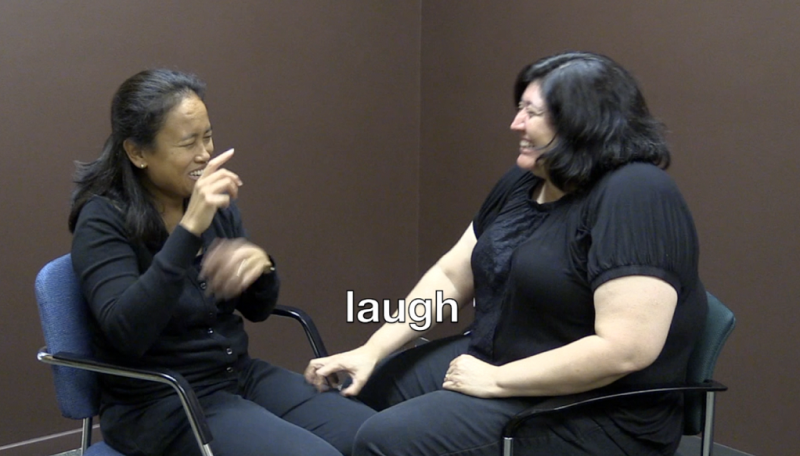Haptics Video 1: Introduction to Haptics
Haptics: A standardized system for providing and or receiving visual and environmental information as well as social feedback via touch signals on the body.
Video description: A close up of a woman signing into the camera.
Hello I’m Maricar Marquez. I’m going to be talking to you about Haptics. This is the sign for Haptics.
Image description: Both hands are positioned palm facing down at chest level with elbows bent. The right hand is placed on the left wrist and then the left hand is placed on the right wrist. This happens in a fluid motion.
Haptics is a method that affords people access to environmental, visual and social information. This information is critical for individuals who are DeafBlind as it affords them the ability to make choices and/or decisions based on the environment they find themselves in. It allows a more complete “vision” or perception of the setting and the content within. Please keep in mind, I am not speaking of information that is communicated through speech or American Sign Language but rather a person’s facial expression, that might look facetious, something I might overlook because I simply cannot “see” it. Haptics allows me to have a full understanding of what is happening around me. It completes the picture for me.
TITLE SLIDE: Examples of the type of information that one can receive using Haptics include: Visual and Environmental information such as facial expressions, directional information, size amount and intensity, actions, layout of a room or area, food or drink items, identifying people, and description of people and objects. Haptics can also provide social feedback such as personal reactions, directives, prompting, confirming or negating, identifying oneself, and sharing personal emotions. And so much more
Haptics is a system of standardized signals but note, it is not a language. These signals have specific parameters and are placed in a specific location and have specific meanings.
TITLE SLIDE: People who are DeafBlind use a variety of methods to access visual and environmental information. Haptics is only one method.
DeafBlind people receive information in a variety of ways, including speech, sign language, text and/or touch.
TITLE SLIDE: There are benefits to receiving visual and environmental information via touch (Haptics).
The two main benefits of Haptics over other methods is that it affords the receiver the ability to receive information in real time. And it allows the ability for it to be conveyed discreetly. Typically, while communicating there is a lot of turn-taking, or waiting before you can respond. Using Haptics, one is able to provide feedback without disrupting the flow of the communication actively engaging in the conversation.
For example, suppose I am facilitating a large group meeting, where I’m at the head of the room and my boss walks in. My provider cannot interrupt my presentation, while I’m speaking in front of a large audience to give me this critical piece of information, it’s obtrusive and potentially disruptive. Through Haptics my provider can discreetly, in real time, give me this information and I can continue my meeting ensuring that I am aware that this key person has entered the room. Again, it’s done discreetly.
Image description: Here is an image of Maricar at a recent Haptics training. To her left is a tactile interpreter who is interpreting a question that’s being asked by a member in the audience. And to her right is a Haptics provider who is providing Haptic signals on her back.
I just shared an example of how Haptics can be used to receive visual and environmental information for the meeting I was facilitating. Now I’d like to talk about using Haptics to receive personal interaction or feedback in a one on one or small group setting.
So, I’ve spoken a lot about how Haptics can be beneficial in a large group setting but now I’d like to hone in on its benefits in 1:1 or small group setting. Haptics affords a DeafBlind person the opportunity to glean information such as laughter, someone smiling, perhaps looking quizzically that happens in a conversation where I might miss these cues if I’m unable to access them visually. The addition of this type of feedback allows me to engage instantly, appropriately, and actively be part of the conversation and with those around me.
TITLE SLIDE: How Haptics has Impacted My Life
Haptics is such a tremendous resource. As a DeafBlind person I highly value the ability to access the information around me. But as my vision deteriorated, as my hearing deteriorated I simply didn’t have the same access to information and I lost my connection to things around me. Haptics has given that back to me.
TITLE SLIDE: For more information…
For more information on Haptics, we have a wealth of information available to you. The Helen Keller National Center is available for questions, please contact us. We have online courses, we have training available, we have a Haptic book. Feel free to reach out to HKNC at any time.
TITLE SLIDE: Contact HKNC at: PLD@hknc.org [End of Transcript]
Haptics Video 2: How did the Helen Keller National Center (HKNC) learn about Haptics?
How did the Helen Keller National Center learn about Haptics?
Video description: A close up of a woman signing into the camera.
You might be wondering how the Helen Keller National Center became involved with Haptics. A group of people representing an organization called Hapti-Co visited HKNC. During this visit, they provided us with information on Haptics.
TITLE SLIDE: Hapti-Co is an organization that was developed to serve the DeafBlind community by providing continued education, training, and resources on the use of Haptic Communication. Hapti-Co staff travel around the world to share this system with all who may benefit.
Here’s an image from one of the trainings provided by Hapti-Co at the Helen Keller National Center. The presenters are in the front of the room with a large PowerPoint behind them. There are approximately 30 people seated at tables throughout the room. There are a combination of interpreters and participants. Many of the participants are receiving interpretation via tactile ASL. A second interpreter is providing the Haptic signals on the person’s back copying the signals being presented in the front of the room.
A book was published in Norway that outlined the signals used in Haptics. HKNC collaborated with the authors of that book, Hapti-Co, to create an American version that was sensitive to the linguistic and cultural needs of DeafBlind Americans. We wanted to ensure that it met the needs of the American DeafBlind community and their perspectives.
Here is an image of the book, Haptic Communication, the American Edition. On the cover are two women standing outside in front of a pond with trees all around them. One woman is providing Haptic signals to the other.
TITLE SLIDE: For more information about this publication please contact us at pld@hknc.org [End of Transcript]
Haptics Video 3: Who uses Haptics?
Who uses Haptics?
Video image description: Close up of a woman signing into the camera.
At this point, you might be wondering who uses Haptics? This is not only for interpreters. It is for anyone! Interpreters, SSPs, family members, friends, service providers, DeafBlind people, truly anyone!
TITLE SLIDE: Examples of Haptics in Use in Various Settings
Image description: Here is an image of Maricar and a young girl shopping at an outdoor market. Maricar has a necklace in each hand. The young girl is using Haptics to let Maricar know the color of each necklace.
And here’s an image of a DeafBlind woman filling up a pot at the sink. Her young son is using Haptics to let her know when the pot is full.
And finally, here we have a vocational trainer using Haptics to provide feedback to a young DeafBlind man who is working in the laundry room of a local hospital.
A DeafBlind person can be either a provider or receiver of Haptic communication, as can interpreters, SSPs, family members, friends or service providers. We can all become provider or receiver in an instant! For example, I, as a DeafBlind person, can also either be a receiver or a provider of Haptic communication. My husband is hearing and sighted and you would think he’d be the provider of information but he CAN sometimes be a receiver as well. We’re often are out and about biking throughout NYC. Some of our trips can be as far as 40 miles. We ride a tandem bike, where I sit in the rear.
Here’s an image of Maricar and her husband riding their tandem bike in the city.
And if I need to tell him something like, “Hey, I need to stop and use a restroom,” I use haptics on his back by drawing a “T” which lets him know that I need to stop. In this situation, I can’t use speech or sign language to communicate, but through Haptics I can become the provider of information to him and get him to understand what my needs are; that I need to stop.
Now, please keep in mind, that not all providers and receivers are going to know every single signal used in Haptics but rather use the signals that are appropriate for you and the setting for which you need them. There are some receivers who want to know all the information they can possibly get in a given environment, whereas others may only want to focus on a few key elements, so it really does depend on individual preference and situation. [End of Transcript]
Haptics Video 4: Prioritizing Information
How do you determine what information to prioritize when providing visual and environmental information?
Video image description: A close up of a woman signing into the camera.
You might be wondering how a provider can prioritize information they give to the receiver. First and foremost, you want to use the information that will allow the DeafBlind person a more complete picture of their surroundings.
TITLE SLIDE: Factors that Influence the Type and Amount of Information to be Provided Include:
- Situation or Setting
- Role of the Receiver
- Current Status of Vision and Hearing
- Age of Onset
- Personal Preferences
TITLE SLIDE: Situation or Setting
Other things that may influence how you prioritize information include setting type, is it more formal or more casual, is it a school setting, a meeting perhaps or a job interview, or is it more social, like a recreation event or social gathering?
TITLE SLIDE: Role of the Receiver
What is the DeafBlind persons role in this setting? Is the DeafBlind person facilitating a meeting or discussion or are they a participant? If the DeafBlind person is leading the meeting or perhaps in a teaching role, the type of information that provided to them might be more plentiful as they need that information to stay on task and manage the situation whereas, if the DeafBlind person is a participant may require less information to be an active participant in the setting.
One example comes to mind, I am a Supervisor of a department and one of my functions is to hold weekly staff meetings. As the facilitator, all dialogue is being provided to me through a tactile American Sign Language who is seated to my left. I don’t have enough usable vision to see if my staff are attending to me, are they looking at me oddly, are they looking down, texting, rolling their eye, or chatting – all of this is unbeknownst to me? I need to know reactions so I can manage them effectively. So if, for example, two staff people are chatting with each other, I can interrupt and ask what they are talking about. If someone rolls their eyes, I can immediately ask about their reaction to what just happened so we can have a dialogue about the content.
Now as a participant I would also be oblivious to the chatter going on around me as I am attending to the speaker at hand. Since I’m not facilitating the meeting, that chatter is not as pertinent to me. Typically, a participant requires less information than one who is facilitating or leading a meeting.
TITLE SLIDE: Age of Onset and Current Status of Vision and Hearing
Let’s talk a bit about when one’s vision loss and hearing loss occurs. I grew up Deaf and later started to lose my vision. I had an excellent visual memory, was able to see and recognize colors, a great fashion sense and was able to see what people looked like but as my vision started to deteriorate, this type of information vanished. However, I highly valued and wanted this type of information. I wanted to know the color of things, what someone looked like, what clothes people were wearing.
Conversely, someone who was born blind does not have a visual memory, has never seen color or what people look like or what clothes they are wearing. The type of information that they value is not inherently the types of information we would want are different. So color, type or style are likely meaningless for them.
TITLE SLIDE: Personal Preferences
Personal preferences will vary based on setting, based on the role of the DeafBlind person and quite honestly their individual priorities. Some people may want an enormous amount of information whereas another person may want significantly less information. For some, too much information is simply overwhelming. [End of Transcript]
Haptics Video 5: What is the Difference between Pro-Tactile and Haptics?
Title slide: What is the Difference between Pro-Tactile and Haptics?
Video image description: A close up of a woman signing into the camera.
You might be wondering what IS the difference between Pro-Tactile communication and Haptic communication. Let’s talk about it! Pro-Tactile communication is diverse and expansive whereas Haptic communication is simply a standardized system of signals. Haptics is not a language. Pro-Tactile communication is a philosophy, a language, a culture, and a movement. It is intended to promote equality and access for individuals who are DeafBlind and was created by DeafBlind people. Pro-Tactile can be used in a one-on-one or group setting, but it is not standardized. The use of touch is more intrinsic and organic where communication partners decide what is best for them through touch.
We at the Helen Keller National Center support and promote all individuals right to choose whatever method or philosophy that works for them. For more information about the Pro-Tactile movement, please visit www.protactile.org [End of Transcript]
Haptics Video 6: How can I learn more about Haptics?
How can I learn more about Haptics?
Maricar Marquez
Video image description: A close up of a woman signing into the camera.
To learn more about Haptics there are a number of free resources on the Helen Keller National Center website. Trainings are available in your local communities provided by HKNC staff. There are also opportunities to attend training at the Helen Keller National Center. A great reference is the American edition Haptic Communication adapted from the original Norwegian version. If you would like more information, please contact HKNC’s IRPD department.
TITLE SLIDE: Contact HKNC at: PLD@hknc.org or go to www.helenkeller.org/hknc [End of Transcript]
Haptics Video 7: How Haptics has Impacted my Life
How Haptics has Impacted my Life
Video image description: A close up of a woman signing into the camera.
As a DeafBlind person, who is culturally Deaf, I was amazed at the impact Haptics has made on my life as I was losing my vision. It has filled in the gaps of information that have been missing for so long…in social situations, on the job, and everyday life. I really cannot emphasize enough how much the use of Haptics through touch has enhanced my life in terms of information I’ve gotten from my husband, family, friends, interpreters, SSPs and colleagues in my everyday life.
As an active theatre goer, I now not only rely on the tactile American Sign Language interpreter who provides me access to the dialogue of the actors but with the addition of a Haptic communicator providing information on my back, I am able to envision the show more holistically so that I can see the whole setting. It thoroughly enhances my understanding and enjoyment of the production.
I now use Haptics more consistently in my work as an instructor while working with students. Socially, in one-on-one settings it affords me the ability to converse in real time. The analogy that comes to mind is that life before Haptics is like talking to a wall. The wall is my vision loss, my inability to see the person I’m talking to. Communication is static, dry, just words. Haptics tears down the wall and allows me to “see” all that I’ve been missing; the benefit is astounding. [End of Transcript]



